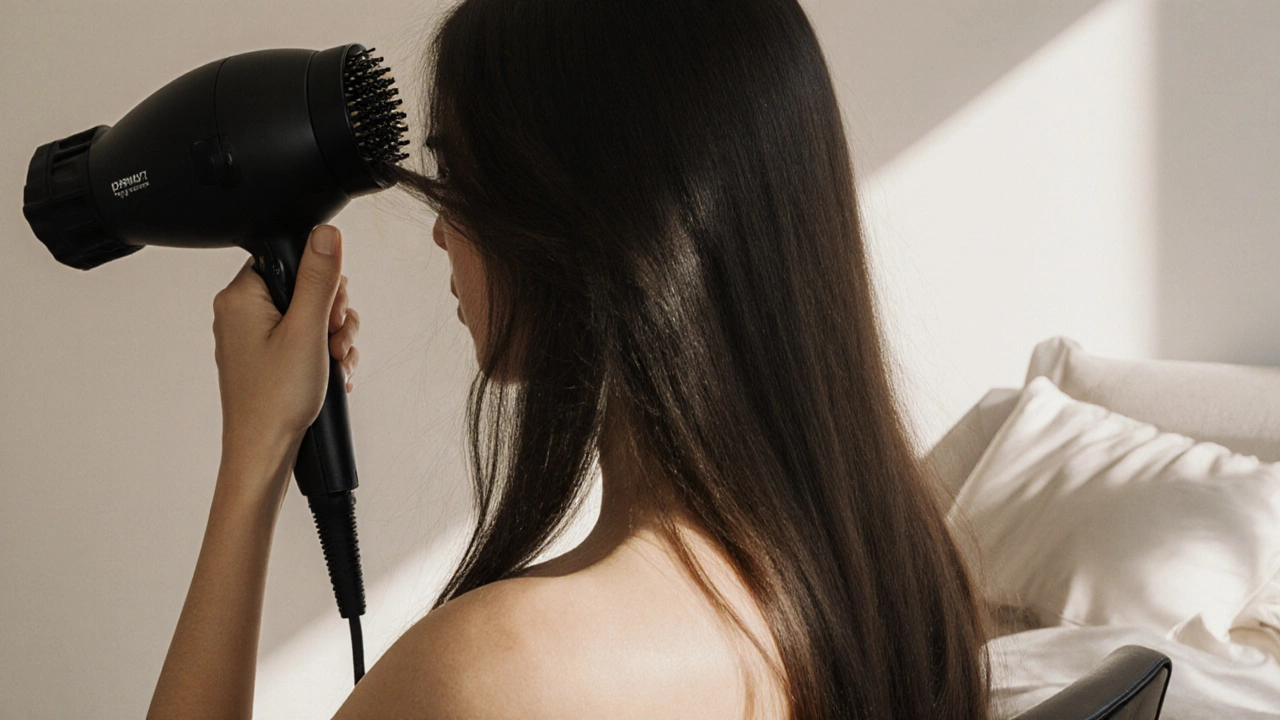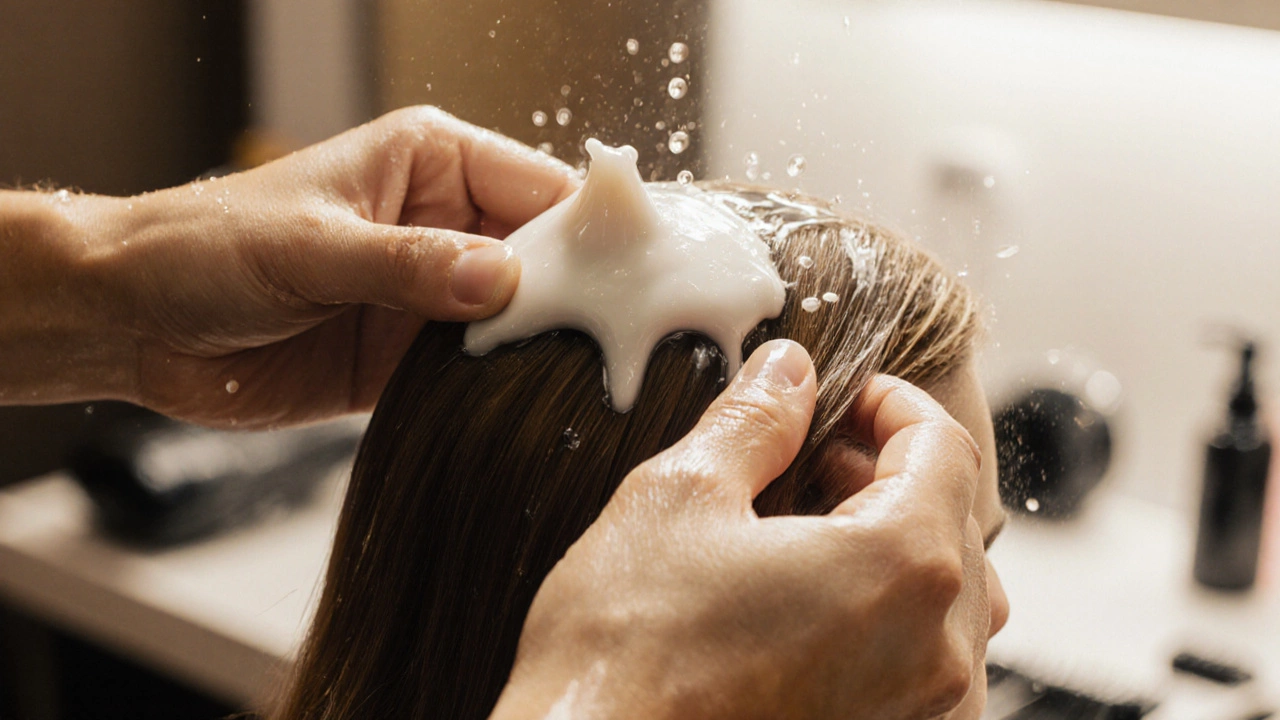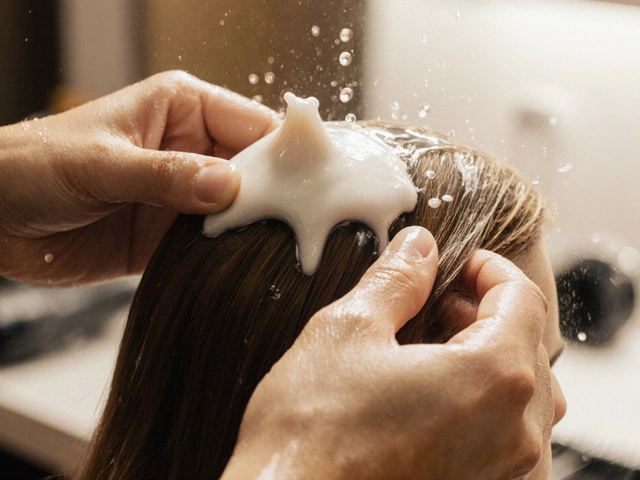Silky Hair Ingredient Checker
Check Your Hair Products
Find out if your current products contain the key ingredients that hairdressers use to create silky, smooth hair.
Key Ingredients Used by Hairdressers
Essential Ingredients for Silky Hair:
- Dimethicone - Smooths cuticle and reduces frizz
- Hydrolyzed Keratin - Repairs damage and strengthens hair
- Argan Oil - Lightweight moisture and shine
- Marula Oil - Deep penetration and humidity protection
- Polyquaternium-7 - Heat protection and moisture retention
- Silk Amino Acids - Bonding and repairing cuticle damage
Remember: Effective ingredients should be in the first 3-5 ingredients on the label
Ever wonder why your hair feels like silk after a salon visit-but turns frizzy or dull just a few days later? It’s not magic. Hairdressers use a mix of professional-grade products and techniques that most people never see in stores. You don’t need to spend hundreds of dollars, but you do need to know what’s actually in the bottle-and what’s just marketing.
Conditioners Are the Foundation
Every salon visit starts with shampoo, but the real magic happens in the conditioner. Hairdressers don’t use the same drugstore conditioners you buy. They reach for salon-only formulas with higher concentrations of emollients like dimethicone, cetyl alcohol, and hydrolyzed keratin. These ingredients don’t just moisturize-they coat each strand to smooth the cuticle, the outer layer of your hair that gets roughed up by heat, chemicals, and brushing.
Think of your hair like shingles on a roof. When they’re lifted or damaged, your hair looks frizzy. When they’re flat and sealed, light reflects evenly, and that’s what makes hair look silky. Salon conditioners are thicker, richer, and left on longer-often 5 to 10 minutes under a heat cap. That’s why your hair feels different after a salon wash compared to your quick rinse at home.
Leave-In Serums and Oils Are the Secret Weapon
After blow-drying, most stylists apply a tiny drop of leave-in product. It’s not just any oil. The go-to choices are argan oil, marula oil, and silk amino acids. These aren’t heavy like coconut oil-they’re lightweight, fast-absorbing, and designed to sit on the surface without weighing hair down.
Argan oil, for example, contains high levels of linoleic acid and vitamin E. It reduces frizz by sealing in moisture and creating a protective barrier against humidity. Marula oil has even smaller molecules, so it penetrates deeper and lasts longer. Silk amino acids mimic the natural proteins in your hair, helping repair micro-damage from coloring or heat tools.
Stylists use maybe half a droplet-just enough to smooth the ends and add shine. Too much, and your hair looks greasy. That’s why your DIY attempts fail: you’re using too much, or the wrong kind.
Heat Protectants Are Non-Negotiable
If your hairdresser uses a flat iron or blow dryer (which they almost always do), they’re using a heat protectant. These aren’t just sprays with “thermal protection” on the label. Real ones contain polyquaternium-7 and hydrolyzed wheat protein, which form a flexible film around each strand. This film holds in moisture and prevents the 400°F heat from boiling water inside your hair shaft-which causes breakage and frizz.
Most drugstore heat protectants evaporate too quickly. Salon versions are thicker, stay on longer, and often include silicones that create a glass-like finish. You can buy them online or at beauty supply stores, but skip the ones with alcohol as the first ingredient. Alcohol dries out hair, defeating the whole purpose.

Professional Smoothing Treatments (Temporary and Semi-Permanent)
For clients with stubborn frizz or coarse texture, stylists might recommend a smoothing treatment. These aren’t keratin treatments you see advertised on TV. The real salon versions use formaldehyde-releasing agents (like methylene glycol) in low, controlled doses. They’re applied, flat-ironed at high heat, and sealed into the hair. Results last 2-4 months and turn even curly hair into sleek, glassy strands.
There are also formaldehyde-free options now, like Brazilian Blowout Zero or Goldwell Kerasilk. They use hydrolyzed silk and plant-based polymers to temporarily bond the cuticle. They’re safer, but don’t last as long. Still, they deliver that salon silkiness without the chemical smell.
These treatments aren’t for everyone. If your hair is fine, color-treated, or already damaged, they can make things worse. Always ask your stylist to do a strand test first.
The Role of Blow-Drying and Brushing
Products alone won’t make your hair silky. Technique matters just as much. Stylists don’t just dry hair-they dry it with direction. They use a round brush, pulling hair taut as they blow-dry. This stretches the strand, flattens the cuticle, and locks in smoothness.
They also use cool air at the end. That’s not just for comfort. Cold air contracts the cuticle, sealing in the smoothness created by heat. It’s the same principle as tempering glass. Heat shapes it, cold locks it.
At home, try this: dry your hair in sections. Start at the roots, pull the brush down to the ends, and keep the dryer pointed downward. Finish with 30 seconds of cool air. It takes five extra minutes, but the difference is night and day.
What They Don’t Put In Your Hair
There are a lot of myths. Hairdressers don’t use “miracle” oils like olive oil or honey. They don’t spray glitter or leave-in conditioners that claim to “repair” hair in minutes. Real silkiness comes from consistent care, not one-time fixes.
They also avoid products with sulfates, parabens, or heavy mineral oils. These clog the cuticle, trap dirt, and make hair look dull over time. Even if a product says “natural,” if it’s thick and greasy, it’s not the right fit for silky hair.

How to Replicate Salon Silkiness at Home
You don’t need to go to the salon every week. But you do need to invest in the right routine:
- Wash with a sulfate-free shampoo designed for smoothness.
- Use a salon-grade conditioner and leave it on for at least 5 minutes.
- Apply a pea-sized amount of argan or marula oil to damp hair, focusing on mid-lengths to ends.
- Always use a heat protectant before blow-drying or straightening.
- Blow-dry with a round brush and finish with cool air.
- Once a month, try a professional smoothing treatment if your hair is coarse or frizzy.
Stick with this for three weeks. You’ll notice your hair feels smoother, looks shinier, and tangles less. That’s not luck-that’s science.
What to Avoid
Don’t use hot tools every day. Even with protection, heat builds up damage over time. If your hair feels straw-like, take a break.
Don’t sleep on cotton pillowcases. They rub against your hair, lifting the cuticle and causing frizz. Swap them for silk or satin. It’s cheap, easy, and works.
Don’t wash your hair every day. Overwashing strips natural oils. Try every other day, or use dry shampoo in between.
Don’t believe in “miracle” products that promise instant results. Real silkiness takes time, consistency, and the right ingredients.
Can I get silky hair without spending a lot of money?
Yes. You don’t need salon-priced products. Look for drugstore brands that list dimethicone, hydrolyzed keratin, or argan oil as top ingredients. Brands like OGX, Garnier Fructis Sleek & Shine, and SheaMoisture have affordable options that work. The key is consistency-not price.
Why does my hair get frizzy after I wash it?
Frizz happens when the hair cuticle lifts and absorbs moisture from the air. This is common with humid weather or damaged hair. To fix it, use a leave-in conditioner with silicones or oils that seal the cuticle. Avoid rough towel-drying-use a microfiber towel or an old cotton T-shirt instead.
Are keratin treatments safe?
Traditional keratin treatments use formaldehyde, which can irritate eyes and lungs if not handled properly. Salon professionals are trained to use them safely, but they’re not ideal for pregnant women or people with asthma. Formaldehyde-free versions are safer and still effective. Always ask your stylist for the ingredient list before booking.
How often should I get a smoothing treatment?
Most treatments last 2 to 4 months, depending on your hair type and how often you wash it. If your hair grows fast or you wash it daily, you may need a touch-up sooner. Don’t do them more than every 3 months-over-treating can cause breakage.
What’s the difference between a serum and an oil for hair?
Serums are water-based and contain polymers or amino acids that smooth the cuticle without greasiness. Oils are lipid-based and moisturize deeper. Most stylists use both: a serum for shine and control, and a light oil for hydration. You can use a serum daily; oils are better 2-3 times a week.
Final Tip: It’s About the Cuticle, Not the Product
Everything that makes hair silky-serums, oils, heat protectants, treatments-works by managing the hair cuticle. Smooth cuticle = shiny, soft, tangle-free hair. Damaged cuticle = frizz, dryness, breakage. The best products don’t change your hair’s structure. They just help it behave better.
Stop chasing quick fixes. Start caring for the surface of your hair like you care for your skin. Protect it, seal it, and treat it gently. That’s what hairdressers do. And that’s how you get hair that feels like silk-not just looks like it.

